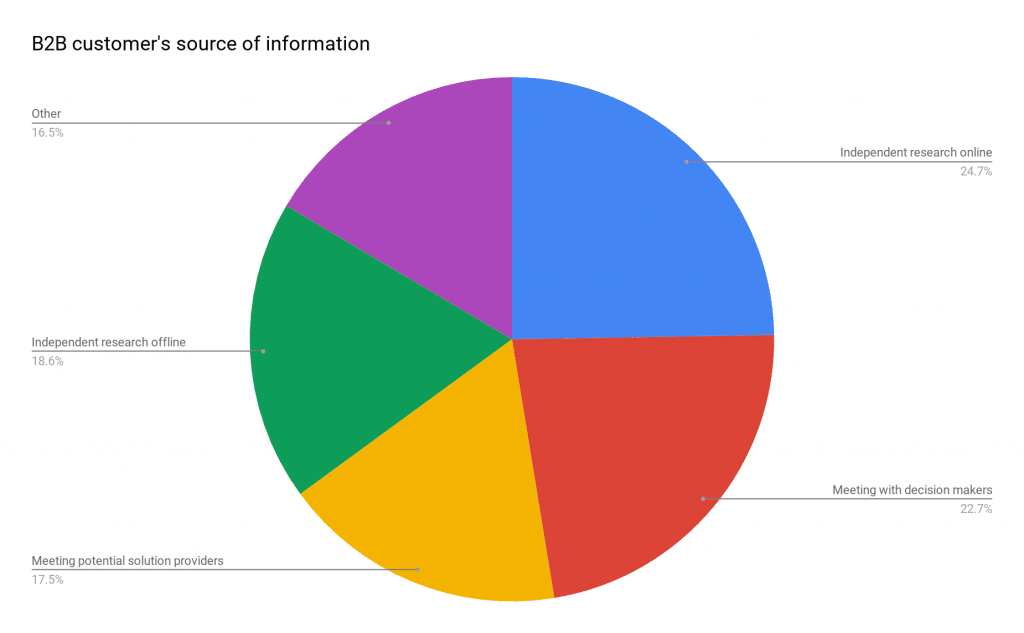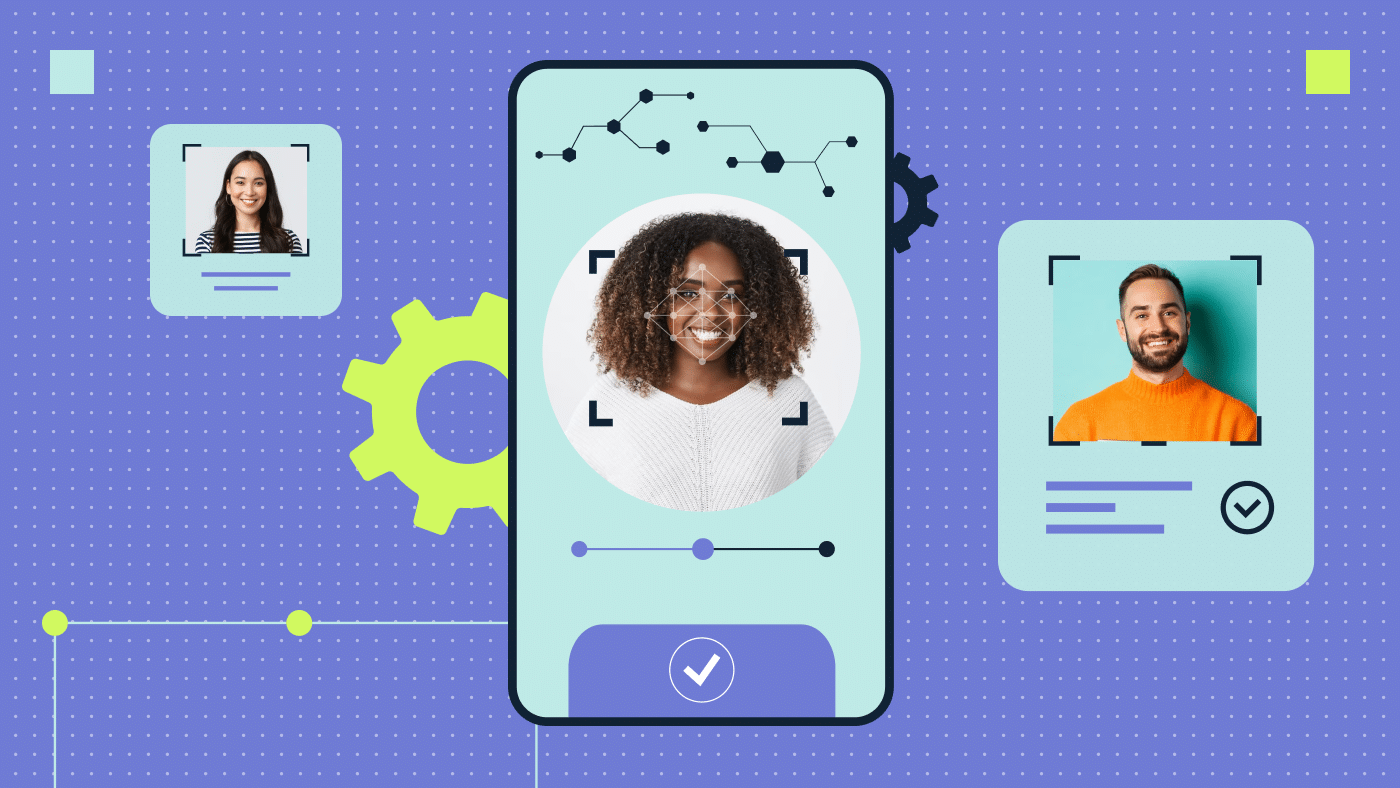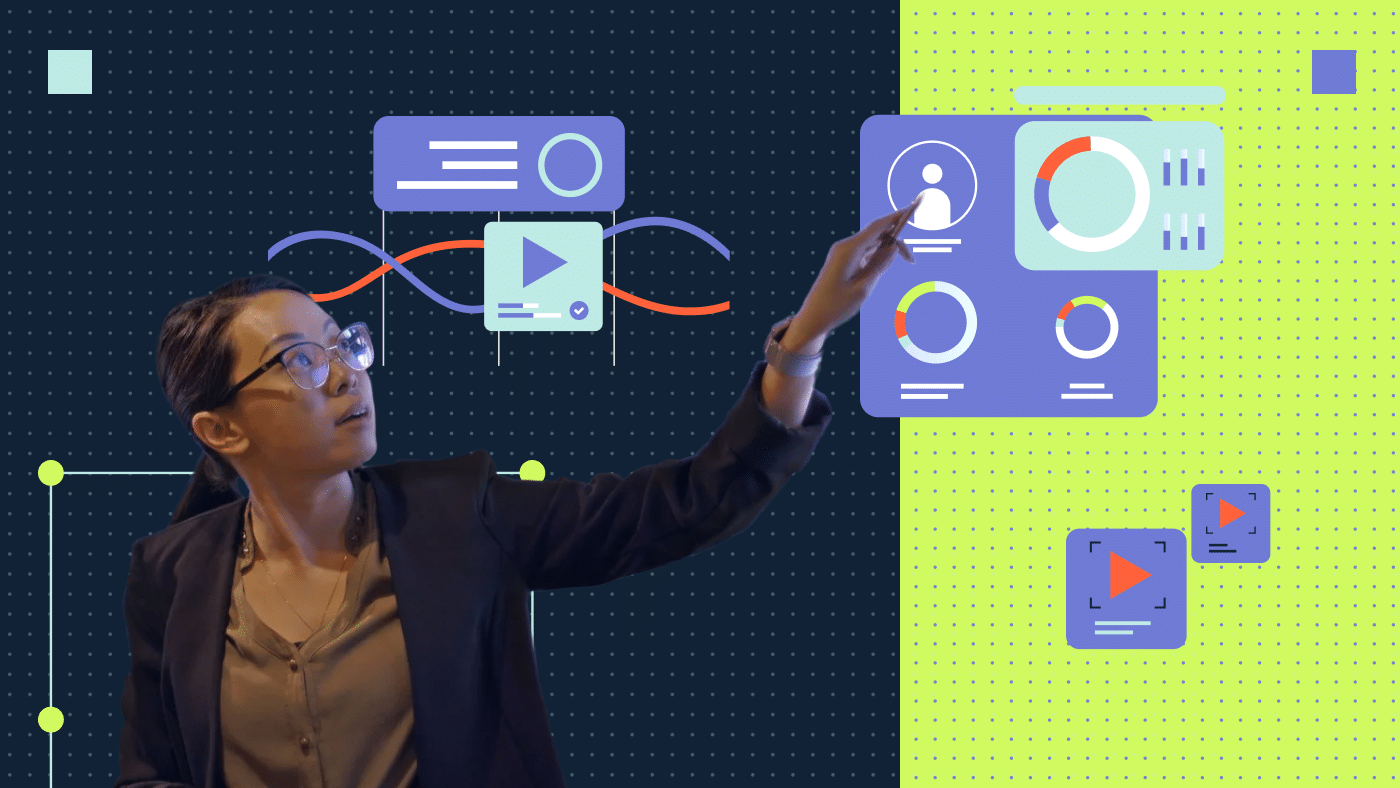It seems so obvious that you can find almost any, if not every answer in Google. I won’t argue that, but when it comes to finding the right business solution, it’s painful to search-out valid information to make an informed decision due to the amount of information available for research. Now imagine how hard it is to seek out and agree on information for a combined decision of 5 to 10 people, in different departments, working for the same business ?
In this post I will guide you through the B2B buyer journey to help you understand the challenges that your audience faces every time they need to make a purchase. We’ll also cover the responsibility of marketing within the sales process.
Summary | In case you’re between meetings
1. What do B2B purchasers consider when searching for your services? – companies are made of different departments that interact with each other to make the business work. Each company & department is led by a decision maker, assisted by a team. B2B businesses seek vendors that align with their own interests and can provide value to their relationship.
2. What’s a buyer journey – a series of actions – a metaphorical route- that customers follow to complete a purchase. Here’s why you should care:
- To improve sales & marketing performance within 12 months
- To listen to your audience & deliver what they actually expect
- To enhance brand awareness & impact within your industry
3. Differences between B2B and B2C buyer journey – B2B journey involves multiple people and multiple goals. Leads may change stages based on the complexity of their internal decision process. In contrast, the B2C journey is quick & simple, research & decisions are executed by the buyer.
- The role of marketing in the sales process – marketing & sales need to work together to facilitate client nurturing, engage quality leads and shorten sales response times.
4. Purchasing challenges of B2B companies – Before defining the steps of your customers’ buyer journey, consider the different “tasks” they need to work on to:
- Identify the current problem(s)
- Analyze the different problem causes
- Evaluate possible solutions based on benefit vs cost
- Validate the high-level solution approach to company’s problems
- Implement & train the team to realize adoption
- Continue supporting & optimizing adopted solution
4.2. Why B2B decision makers are misunderstood by vendors – most B2B sales & marketing teams misunderstand what customers go through during software/product selection. As such, they deliver generic content that doesn’t correspond to or impact the stage in which the purchaser is in.
4.3. What’s a persona?
4.4 The influence of content marketing in buying process
5. Mapping you company’s buyer journey
5.1. Describe the sales pipeline stages – Does your sales team understand decision-makers (leads)? Depending on the complexity of your leads, sales reps will need to meet with multiple decision makers while negotiating.
5.2. Define your buyer journey according to the B2B sales pipeline – What key questions need to be addressed to move forward? Decision makers need to accomplish their task’ goals, you need to help them make informed & speedy decisions.
5.3. Match the buyer’s journey with your content & advertising strategy – Are your deal stages in the sales process mapped towards the journey? Define your lead characteristics to facilitate marketing campaign segmentation to improve marketing & sales productivity.
6. The B2B golden rules
7. Learn more, sell better: informative sales & marketing posts, designed to make you more dollars.
1. What do B2B purchasers consider when researching your services?
Reality check…a Gartner survey revealed that from the overall purchase cycle only 17% of time is spent on meetings with sales reps…ouch. We live in a fast-information age, most B2B purchasers do their research independently, this makes it harder for sales reps to influence them early on in their research phases.
That being said, B2B decision makers are looking for insights and information that support their perceived needs. They tend to carry personal and professional biases, sales and marketing teams need to identify those and build an approach plan for maximum influence. At the time a sales rep gets an opportunity, researchers are usually worried about:
- What is my industry doing to stay competitive?
- How would it benefit the business?
- How much does the solution cost?
- How will my team be impacted?
- How long would it take to realize the benefit?
Whenever we refer to B2B marketing, we need to keep in mind the fact that B2B and B2C industries are different but can share a similar path. Each target segment has its own requirements and still, the process tends to become long due to all the decision makers involved in it. Like any relationship, the secret to sales lies in communication & bonding skill.
2. What’s a B2B buyer journey?
“A well-built B2B buyer journey maps the purchasing process of your typical customer, the marketing & sales team must deliver the right information at the right time to the targeted buyer throughout their journey. By delivering relevant content which enables decision making, your prospect will gain trust in your team over your competitors, giving you swaying power.” – Anna T Gladkaya, Content Strategy
Buyer journey is the term we use to describe the process that customers go through to complete a purchase. As marketers, we need to describe precisely the different stages they face in their unique decision process.
The reason why many B2B sales reps fail in their attempts to engage a lead is the inherent complexity of dealing with different opinions & approval structures.
- Marketing & Sales need to understand the persona type they are speaking with
- Sales reps need to match the persona business needs to successfully close a deal
3. Differences between B2B and B2C buyer journey
Let’s be clear about the fact that most B2B purchasers understand that the sales process is purely a business transaction and it requires a mutual benefit to succeed. However, to overcome competition and enhance engagement, marketers must customize the experience according to user interaction across all brands, channels and lines of business.
A CMO publication by Adobe highlights the benefit of incorporating B2C practices in the B2B buyer journey, showing that B2B companies that use cross-channel tracking increase sales by 59% while improving the quality of customer data by 64%. To provide a holistic marketing experience and follow customers throughout the entire journey, B2B teams need to optimize their process based on customer behavior.
3.1 B2B journey is more complex than B2C
Even when they may look the same, the definition of awareness, consideration and decision is pretty broad to describe the stages in a journey. Normally a B2C purchase is made by one person with the possible input of their social circle, while B2B companies typically have between 5 to 10 decision makers. Consider the time a sales rep needs to invest to convince at least half of the tech team to buy-into the benefits of a new ERP system, IT Security suite or Management consulting services.
When we talk about B2B, it helps to think of each stage of the journey as “tasks” because at the end, different job positions play a role in the negotiation. Each target persona’s position has a task which needs to be accomplished in order to move the sale forward.
3.2 The B2B buyer journey is not a one way street
Once leads enter the sales pipeline, it is normal for them to go back or skip certain stages depending on their internal processes, you’ll never have it perfectly mapped, but you can be close. The journey is a guide that draws the path for marketing & sales teams to develop an influence strategy corresponding to each stage.
However, the sales team must be aware of the concerns that every decision maker involved has along the process. Sales must manage different levels of communication with each team member based on their in-field experience & training. The only way a salesperson can do that, is if they have tailored sales decks, guides, case studies, etc to aid them with the sale.
Different from a B2C journey – which tends to be quick, simple and relatively linear – the B2B route is more dynamic, complex and time-consuming. For this type of industry, buying tasks happen simultaneously & sequentially. To beat the competitors, B2B marketers & sales teams must:
- Create educational resources for the sales team to use
- Identify the opportunities and gaps of every buying stage
- Nurture & follow up with customers along the route
- Utilize partners to enrich the deal with credibility & value

3.3 The role of marketing in the sales process
Most mid-market teams tend to believe that once a lead gets into the sales pipeline, the marketing work has finished. Interestingly enough, these are the ones who also don’t know why they are losing leads 🤔, but that’s another conversation…which I think you’ll totally dig.
Inbound marketing uses content to guide the customer to the right product/service. The goal is to optimize the sales process by delivering relevant information needed by clients to validate the purchase.
Marketing’s job is to provide sales with well-researched leads along with a tool to manage the conversation & interactions. Conversely, sales provides marketing with insights to continue validating the target audience traits & preferences. So yeah, it’s a good idea to stay friends and stop playing blame games 🕊️.
4. Purchasing challenges of B2B companies
When income decreases…normally the one’s to blame are the sales team – not cool bro. The reality is that once the lead finally reaches out to you, they have already done their base research and have a concept of what they want, so sales reps need to match their needs with the company’s proposal – not so simple eh?
Here’s an overview of B2B purchaser’s sources of information which influence their purchasing decision.

Since B2B decision makers hold different roles within a business, every purchase affects their everyday job. We must understand that whenever they reach the sales team, decision makers are expecting someone to support & validate their research…instead of being a talking Ad.
At the end of the day, customers are just looking to solve a specific requirement and the success of the purchase determines their own professional success. At the high-level, Gartner research defines the purchasing task process in 6 stages:
- Identify the problem – “there’s something wrong but we are not sure what it is”
- Explore the possible solutions – “what are the options available to solve these issues?”
- Build a list of requirements – “what do we need to solve the problem”
- Select the right partner – “who can help us achieve the requirements?”
- Test the solution – “we need to validate the functions of the solution to ensure it meets our requirements”
- Purchase – “we need to train the team on how to use the new technology”
4.1 Why B2B decision makers are misunderstood by vendors
B2B purchasers are often frustrated with vendor selection as they don’t feel their needs are understood by the sales rep. This typically happens because of a mismatch of need-to-solution, not listening to the purchasers pain points and treating the purchaser as a one size fits all template…providing them with generic material they’ve already found online.
Sales need to study, listen and analyze their prospects to meet their expectations. To help the sales team, utilizing a CRM system is more than a brilliant idea as it is the one source to track customer interaction, sales productivity & ensure the sales process is followed.
Also, when dealing with too many customers or the wrong audience, it’s easy for sales reps to lose interest, fast. This commonly happen when:
- The sales team isn’t familiar with customer’s current situation
- The wrong content is shared with the wrong target people
- Sales team is overwhelmed with leads – and yes, this can also mean a problem for the business
Pro Tip: Even when there are different stages and filters your sales and marketing teams can use to segment your CRM base, always track your KPIs to improve your efforts – if you don’t know which KPIs to track, swing by this post.
4.2 What’s a persona?
Of course, a journey explanation isn’t complete without chatting a tad about personas, understanding of which, can make or break a business.
In the magic world of marketing and user-centric design, personas are fictional characters built to represent the personality profile of people that are interested in your services/products.
By defining personas, you can segment the audience, campaigns and content to better meet the customer’s unique reality, and influence their decision making process. This also helps provide valuable insights to the sales team on how to approach prospects/leads.
Sounds wonderful – but the results are even better. Since personas are built from data-analysis and behaviour research, you will get a completely new level of understanding with your audience. Always remember that every user persona represents a user group that has their own desires, dispositions, fears and motivations. Personas are helpful to:
- Understand the worries or questions your customer has
- Highlight motivational triggers that drive them to take action
- Increase the empathy between sales and leads due to a clear understanding of their personalities
4.3 The influence of content marketing in the buying process
Every purchase starts with a problem that leads users to search for solutions. During every stage of their research, there will be different questions that need to be answered to continue the process until they are comfy making a purchase. As we’ve learned, B2B buyers are typically independent researchers, so marketing has to be timely to deliver the support information to users to sway them to purchase from you.
Successful B2B content marketing strategies benefit your company and the customer, building your sales & marketing processes around the customer -not your services- is key. Content must serve to enable the sales team to sway a prospect’s decision making, while providing enough valuable insights to the audience.
5. Mapping the buyer journey
Now that we’ve covered the basic concepts of the journey, it’s time to map our sales process and draw-out the buyer journey. I always recommend inviting the sales team to the conversation to get their input on the route they’ve observed and its requirements.
The density of the buyer journey will depend on the complexity of the sale, some businesses can generate immediate leads from social media apps, while others can take months before closing a sale. Keep in mind that the buyer-journey is unique to every business, having a tailored journey is paramount to boosting sales & customer satisfaction.
5.1 Describe the sales pipeline stages
Think about the buyer journey as the vacay you are about to take, then think of the different activities you’re hoping to partake in… Let’s call it -experiences- that you plan to live along the route, those are called “sales pipeline stages”. Your sales pipeline stages define your business’s internal sales process, it describes the buyer journey from the company’s perspective. Hubspot CRM (my fav) for example, has these default stages:
- Connect: the sales team engaged a contact and is in communication. This could happen due to an action in an email campaign, downloading cornerstone material or attending a webinar/event.
- Appointment set: once the conversation starts, it’s time for the sales team to gain the trust of the lead and convince them to get together in an intro meeting. During this phase, the company finally has the chance to introduce the solution and understand customer needs.
- Appointment completed: this stage indicates the success of the meeting and determines if there’s a mutual interest between the company and the prospect.
- Solution proposed: once the sales team qualifies the lead as an opportunity, it’s time to invest more effort in getting the deal. The lead shows open interest in the solution and is evaluating options.
- Proposal sent: this stage indicates that the potential client agrees on the deal terms, the last step before becoming a customer.
As far as sales stages go…most CRMs have stock stages ready, I’d be careful in just using what’s given as that will typically not match your target customer’s journey. The rule-of-thumb is to match the buyer’s journey with the sales stages.
5.2 Define your buyer journey according to the B2B sales pipeline
Let’s clarify that even when the B2B buyer journey is different from B2C, the main structure remains the same: awareness, consideration, action. As an example, we’ll use Gartner’s buyer journey’s 6 stages and match it with the 3 stages of a basic sales funnel to show you how the B2B buyer journey complexity increases due to the uniqueness of your audience.
As a puzzle, match the logical pieces to create the landscape or…the deal process. Below is a high-level example to get you thinking about this, if you need help understanding your customer & building an impact-based journey, I know a few people that can help.
| High-Level Concept | Gartner’s Stages | CRM Deal Stages | Your custom example |
|---|---|---|---|
| Awareness | Identify there’s a current problem | ||
| Analyze which could be the different causes | Connect | Connected | |
| Consideration | Evaluate possible solutions based on benefit / cost | Appointment set | Appointment Booked |
| Contact solution providers / request demo | Appointment completed | Appointment Held | |
| Demo Booked | |||
| All influencers involved | |||
| Demo Held | |||
| Action | Validates the solution approach to company’s problems | Solution proposed | High-Level Scoping Sessions Held |
| Solution & Quote Proposed | |||
| Implement & train the team | Proposal sent | Solution & Quote Sent |
Feel free to add or remove the lead stages according to your internal process. The real key is to be clear about which are the steps customers need to take in order to complete the purchase.
5.3 Match the buyer’s journey with your content & advertising strategy
We are now ready to set the last detail in our buyer’s journey, the influential material that we’ll deliver on each different buying stage. Remember B2B customers don’t follow a linear process, so we must stay open minded and treat every lead unique to their indications of interest.
I’ve mapped out some examples on the content types you can use for each stage. Naturally, you’ll need ample relevant content and a more detailed content plan & KPIs in order to map the journey stages-to-content type delivery. Read the above linked post to learn more on how to qualify every piece of content by analyzing its value to the audience 🧠.
| High-Level Concept | Gartner’s Stages | CRM Deal Stages | Your content journey |
|---|---|---|---|
| Awareness | Identify there’s a current problem | Increase traffic and brand awareness | |
| Analyze which could be the different causes | Connect | Newsletters Infographics Blog posts Checklists Social media updates Email marketing campaigns Sponsored Events Paid Advertising |
|
| Consideration | Evaluate possible solutions based on benefit / cost | Appointment set | Gain leads and develop opportunities |
| Contact solution providers / request demo | Appointment completed | Blog posts Paid Advertising Videos Webinars Hosted Events Case studies Reviews & testimonials Trials |
|
| Action | Validates the solution approach to company’s problems | Solution proposed | Segment the leads by opportunity value & win the sale |
| Implement & train the team | Proposal sent | Demos Scoping Sessions Proposals Consultations |
6. The B2B golden rules
- Understand decision makers (Personas) – ensure sales reps know how to qualify leads by persona and segment them according to the stage & pain point they are facing. Support leads with the right information needed to accomplish research tasks.
- Know the decision making process of your target – as a sales rep, your goal is to create the perfect experience, where the lead can be educated about the benefits of your services. Create a list of possible questions and challenges the personas face to move the sales pipeline forward.
- Map your deal stages to the buyer journey – just like the example above, once you describe the deal stages of your sales process, make sure they’re aligned with the buyer journey for natural lead flow. Remember, the journey highlights the decision patterns of a specific audience based on the complexity of the sale. Thus, having a mapped journey, allows for sales and marketing to deliver relevant information at the right time to sway decision makers’ opinions.
- Align content strategy with buyer stages – identify the type of information needed for each customers’ tasks and make sure your content provides enough value for them. Define your content strategy based on the common questions your sales team tackles.
- Train your sales reps to guide customers – the challenge is to stop talking about your business, and listen to what customers need, while anticipating questions. Pay attention to what your CRM & Web analytics tell you about conversions and always be improving your approach to clients.
Learn more, sell better
- B2B sales key performance indicators – if you want to make this year a success, start by tracking the right KPIs to understand how to optimize sales team performance.
- Hubspot CRM features overview – for our CRM lovers, we explain the main features of HubSpot CRM and how its technology helps your sales team understand your potential customers.






